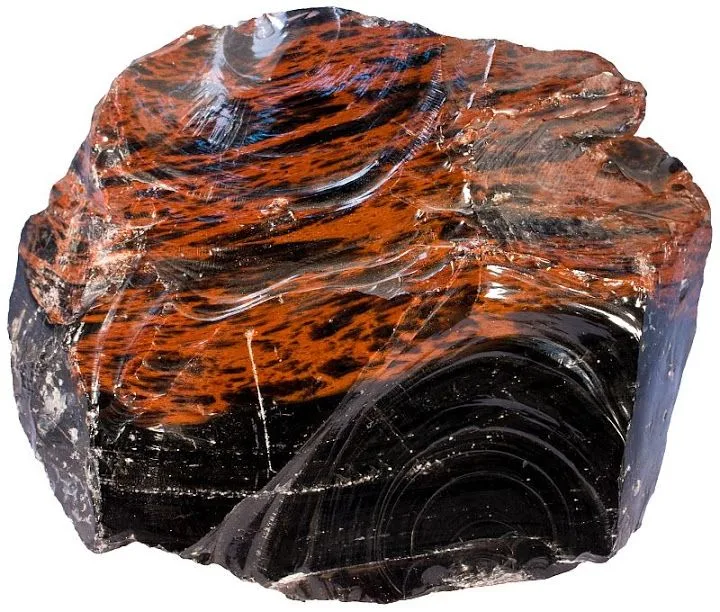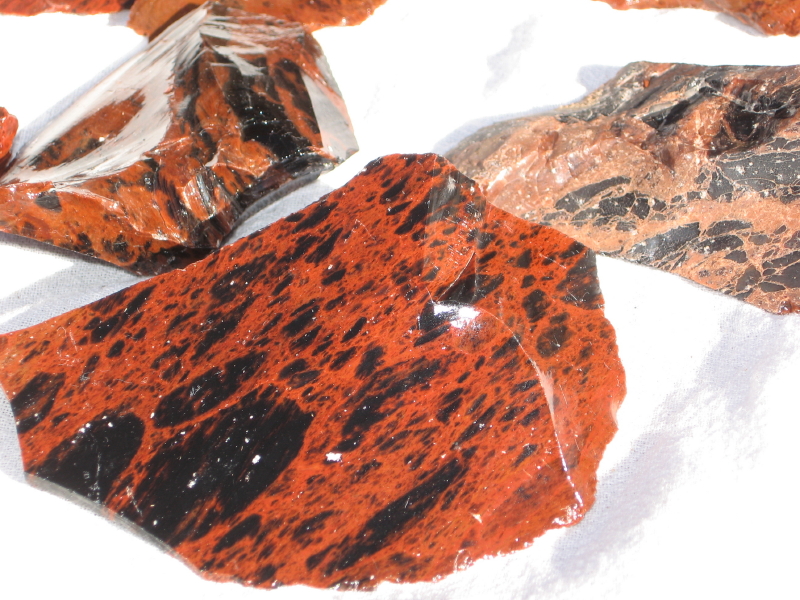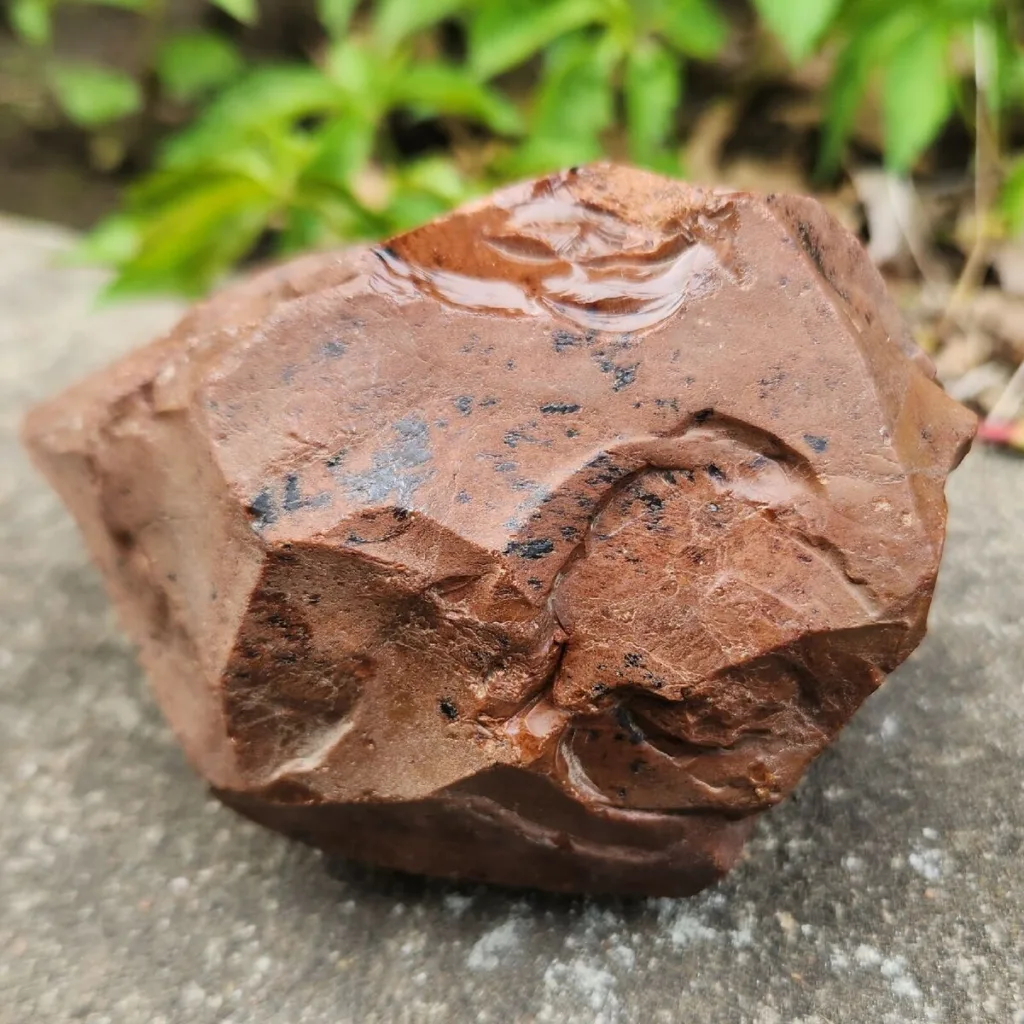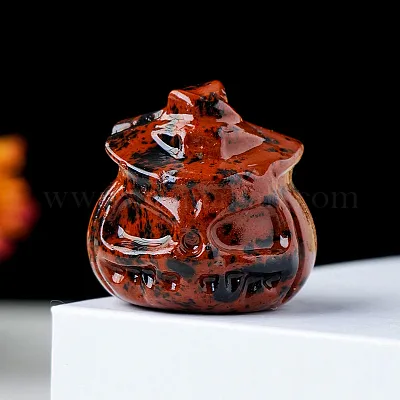Pumpkin Obsidian is a type of natural glass that is formed when lava high in silica content cools quickly. It is a variety of obsidian, which is a volcanic glass that typically has a smooth, glossy appearance. What sets Pumpkin Obsidian apart is its distinctive coloration, which resembles the rich, warm hues of a pumpkin.

Key characteristics of Pumpkin Obsidian include its deep orange to reddish-brown color, often with darker streaks or patterns. This unique coloring is a result of the presence of iron and other mineral impurities in the volcanic glass. The name “obsidian” itself is derived from a Roman named Obsius, who is believed to have discovered a similar type of volcanic glass in Ethiopia.
Obsidian, including Pumpkin Obsidian, has been used by various cultures throughout history for making tools, weapons, and ceremonial objects due to its sharp edges when fractured and its relative hardness. In more recent times, it has gained popularity as a gemstone for jewelry and ornamental purposes.
It’s important to note that the term “Pumpkin Obsidian” is primarily used in the context of lapidary and gemstone enthusiasts to describe this specific variety of obsidian with its distinctive pumpkin-like coloration. The geological processes that lead to the formation of obsidian, including Pumpkin Obsidian, are fascinating and showcase the beauty that can arise from volcanic activity.
Geological Formation

Pumpkin Obsidian, like other types of obsidian, is formed through volcanic processes. Here’s a step-by-step explanation of the geological formation of Pumpkin Obsidian:
- Volcanic Activity:
- The formation of Pumpkin Obsidian begins with volcanic activity. When magma (molten rock) rises to the Earth’s surface during an eruption, it’s exposed to rapid cooling.
- High Silica Content:
- Pumpkin Obsidian, like all types of obsidian, is characterized by its high silica content. Silica (SiO2) is a key component of the volcanic glass, and the high concentration contributes to the glassy texture of obsidian.
- Rapid Cooling:
- The crucial factor in the formation of obsidian is the rapid cooling of the lava. Unlike slow-cooling igneous rocks that allow mineral crystals to form, obsidian cools so quickly that mineral crystals don’t have time to develop. This rapid cooling results in the formation of an amorphous, glassy substance.
- Mineral Impurities:
- The coloration of Pumpkin Obsidian, in particular, is influenced by the presence of mineral impurities. Iron and other trace elements contribute to the characteristic orange to reddish-brown hues. These impurities can create streaks or patterns in the glass.
- Lack of Crystalline Structure:
- Obsidian lacks a crystalline structure due to its rapid cooling process. Instead, it has a random arrangement of atoms, creating a glassy texture.
- Fracture and Sharp Edges:
- When obsidian, including Pumpkin Obsidian, fractures, it creates sharp edges. This property made obsidian a valuable material for toolmaking and weaponry in many ancient cultures.
Key Locations:
- Obsidian deposits, including Pumpkin Obsidian, can be found in various volcanic regions around the world. Some notable locations include:
- United States: Obsidian can be found in areas with a volcanic history, such as the American Southwest (e.g., Oregon, California, and Nevada).
- Mexico: Several Mexican states have obsidian deposits, and Mexico has a rich history of obsidian use.
- New Zealand: Obsidian is found in areas with past or present volcanic activity.
It’s important to note that while obsidian is widespread, the Pumpkin Obsidian variety with its specific coloration might be more localized. Lapidary enthusiasts often seek out specific deposits or sources for the unique Pumpkin Obsidian material.
Physical Characteristics

Pumpkin Obsidian, like other types of obsidian, exhibits distinct physical characteristics that contribute to its unique appearance. Here are some key physical traits of Pumpkin Obsidian:
- Color:
- The most prominent feature of Pumpkin Obsidian is its rich orange to reddish-brown color. This coloration is a result of mineral impurities, particularly iron oxides, present in the volcanic glass.
- Transparency:
- Obsidian, including Pumpkin Obsidian, is generally transparent or translucent. The glassy nature of obsidian allows light to pass through to some extent.
- Luster:
- Pumpkin Obsidian has a glassy luster, giving it a smooth and reflective surface when polished. The lack of crystalline structure contributes to its glass-like sheen.
- Texture:
- The texture of Pumpkin Obsidian is smooth and often described as glassy. When cut and polished, it can have a glossy appearance that enhances its aesthetic appeal.
- Fracture and Conchoidal Cleavage:
- Obsidian, including Pumpkin Obsidian, is known for its characteristic conchoidal fracture. When it breaks, it forms smooth, curved surfaces, creating sharp edges. This property made obsidian historically valuable for toolmaking and cutting.
- Hardness:
- Obsidian is relatively hard, rating around 5 to 5.5 on the Mohs scale of mineral hardness. This hardness contributes to its ability to hold a sharp edge and makes it suitable for various cutting purposes.
- Density:
- The density of Pumpkin Obsidian is relatively high due to its composition of volcanic glass. However, specific density values may vary based on the mineral impurities present.
- Streak:
- Obsidian does not have a streak because it is not a mineral with a defined crystalline structure. Streak tests are typically performed on minerals with a powdered form.
- Pattern and Inclusions:
- Pumpkin Obsidian may display patterns or inclusions, which can add to its visual appeal. These patterns may include darker streaks or patches within the orange to reddish-brown background.
- Shape and Size:
- In its natural state, Pumpkin Obsidian can occur in various shapes and sizes, depending on the geological conditions and the specific location of its formation. Lapidaries often shape and cut it into cabochons, beads, or other decorative items for use in jewelry.
These physical characteristics contribute to the beauty and uniqueness of Pumpkin Obsidian, making it a sought-after material for both collectors and artisans in the field of lapidary arts.
Cultural and Historical Significance

Obsidian, including Pumpkin Obsidian, has played a significant role in various cultures throughout history due to its unique properties and versatile uses. Here are some aspects of its cultural and historical significance:
- Toolmaking and Weapons:
- Obsidian has been highly valued for making tools and weapons by many ancient cultures. Its conchoidal fracture allows for the production of sharp-edged blades and arrowheads. The use of obsidian tools dates back to prehistoric times, and archaeological evidence shows its importance in the development of early human societies.
- Ritual and Ceremonial Use:
- In some cultures, obsidian has been used in rituals and ceremonies. Its reflective and sometimes translucent nature may have contributed to its symbolic significance. The Aztecs, for example, used obsidian mirrors in religious ceremonies.
- Trade and Exchange:
- Obsidian was a valuable commodity for trade in ancient times. The distribution of obsidian artifacts across different regions often indicates trade routes and networks. Specific types of obsidian, such as Pumpkin Obsidian, might have held special value and been traded over long distances.
- Art and Ornamentation:
- Obsidian, including its Pumpkin variety, has been used for artistic and ornamental purposes. It has been shaped into beads, cabochons, and carvings for jewelry and decorative items. The unique coloration of Pumpkin Obsidian makes it particularly attractive for these purposes.
- Spiritual and Metaphysical Beliefs:
- Some cultures attribute spiritual and metaphysical properties to obsidian. It is believed by some to have protective qualities and is used in spiritual practices for grounding and shielding against negative energies.
- Archaeological Discoveries:
- Obsidian artifacts are valuable for archaeologists studying ancient cultures. The presence of obsidian tools and objects at archaeological sites provides insights into trade networks, technological advancements, and cultural practices of past societies.
- Modern Lapidary and Jewelry:
- In contemporary times, obsidian, including Pumpkin Obsidian, remains popular in the lapidary and jewelry-making communities. Artisans and collectors appreciate its unique coloration and smooth texture for creating distinctive and aesthetically pleasing pieces.
- Symbolism:
- The use of obsidian, often associated with sharpness and precision, can carry symbolic meaning in various cultures. Its use in tools and weapons may symbolize strength, while its use in spiritual practices may symbolize protection and grounding.
Overall, Pumpkin Obsidian and obsidian in general have left a lasting impact on human history, reflecting the practical, spiritual, and artistic aspects of the cultures that utilized this volcanic glass.
Lapidary Arts and Jewelry

Lapidary arts involve the cutting, shaping, and polishing of gemstones and other hard materials. Pumpkin Obsidian, being a type of volcanic glass with unique coloration, is a favored material among lapidaries for creating jewelry and ornamental pieces. Here’s how Pumpkin Obsidian is used in lapidary arts and jewelry:
- Cabochons:
- Lapidaries often cut Pumpkin Obsidian into cabochons, which are polished, convex-shaped gemstones with a smooth, rounded surface. Cabochons are popular for creating jewelry like pendants, earrings, and rings.
- Beads:
- Pumpkin Obsidian is also fashioned into beads of various shapes and sizes. These beads can be used in necklaces, bracelets, and earrings, providing a unique and earthy aesthetic.
- Carvings:
- Lapidaries skilled in carving may create intricate designs or sculptures from Pumpkin Obsidian. These carvings can range from small decorative pieces to larger, more elaborate artworks.
- Inlay Work:
- Inlay work involves setting small pieces of gemstone into a base material to create patterns or images. Pumpkin Obsidian, with its distinctive color, can be used for inlay work in jewelry or other decorative items.
- Wire Wrapping:
- Wire wrapping is a technique where wire is used to secure and showcase a gemstone without the need for traditional settings. Pumpkin Obsidian cabochons or beads can be incorporated into wire-wrapped jewelry designs.
- Combined with Other Gemstones:
- Lapidaries often combine Pumpkin Obsidian with other gemstones or materials to create visually appealing contrasts or complementary color schemes in jewelry designs.
- Tumbling and Polishing:
- Tumbling is a process where rough gemstone material, including Pumpkin Obsidian, is placed in a drum with abrasive grit and tumbled to achieve a smooth and polished finish. This technique is commonly used to prepare stones for further lapidary work or for creating polished stones for various uses.
- One-of-a-Kind Pieces:
- Pumpkin Obsidian’s unique coloration makes it well-suited for creating one-of-a-kind jewelry pieces. Each gemstone can have its own distinct patterns and shades, adding to the individuality of the finished item.
- Custom Jewelry:
- Jewelers and artisans may work with clients to create custom pieces using Pumpkin Obsidian. This allows for the incorporation of personal preferences and design ideas into the finished jewelry.
- Artistic Expression:
- Lapidary arts provide a platform for artistic expression. Artists can explore and experiment with different cuts, shapes, and designs to showcase the natural beauty of Pumpkin Obsidian.
In summary, Pumpkin Obsidian is a versatile material in the hands of lapidaries and jewelry makers, offering a wide range of possibilities for creating unique and visually striking pieces of wearable art. The distinctive coloration and smooth texture make it a popular choice for those seeking jewelry with a natural and earthy appeal.




































